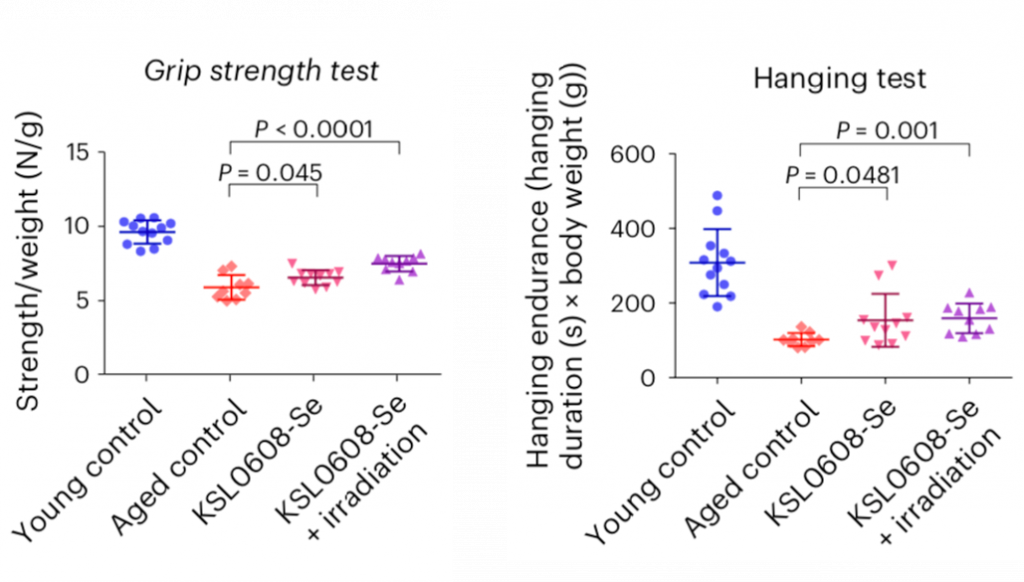Key Points:
- KSL0608-Se is a light-activated senolytic designed to more accurately target senescent cells, potentially in specific organs and tissues.
- Senescence appears in the liver, kidney, and lungs, but not the heart and spleen of aged mice, according to a light-activated technology similar to KSL0608-Se.
- KSL0608-Se counters signs of kidney, liver, brain, and muscle aging, including grip strength and hanging time.
Our cells aren’t perfect, and as we grow, they incur damage that can downgrade them to senescent cells. Senescent cells secrete pro-inflammatory and tissue-degrading molecules that some propose is the cause of aging. This is why senolytics, which selectively remove senescent cells, are being feverishly tested for their age-countering effects. However, current senolytics aren’t perfect either.
Now, researchers from China and the U.K. report in Nature Aging a new technology that addresses some of the limitations of existing senolytics, including toxicity to normal cells, non-specific organ targeting, and effectiveness against different types of senescent cells.
“To the best of our knowledge, no report has described a smart, [senolytic] agent able to achieve all these aims,” state Shi and colleagues, the group that conducted the study.
Shi and colleagues show that the light-activated smart senolytic KSL0608-Se reduces markers of liver and kidney damage in aged mice. KSL0608-Se also improves the grip strength and hanging endurance of aged mice. The technology can potentially be used to target specific regions of the body in humans.
Light-Activation Could Allow for Organ-Specific Targeting
Current senolytic compounds are usually orally or intravenously administered, making it difficult to target specific organs and tissues. Furthermore, while existing senolytics effectively eliminate senescent cells, they can inadvertently destroy healthy cells. For these reasons, the main focus of Shi and colleagues was to design a senolytic that can be controlled in a way that targets senescent cells at the single-cell level.
To address organ targetability, the researcher made the drug light-activable, meaning it works best in regions exposed to specific wavelengths of light. To limit drug activity to a single cell, KSL0608-Se was designed to attach to nearby proteins so as not to diffuse to other cells. Additionally, in an effort to target all types of senescent cells, the drug was designed to work only in the presence of senescence-associated β-galactosidase (SA-β-gal), an enzyme common amongst different senescent cell types.
Smart Senolytic Counters Features of Aging
In a series of in vitro (in a dish) experiments, Shi and colleagues tested the effect of KSL0608-Se in various human cell lines to demonstrate that it is capable of destroying different types of senescent cells, does not destroy young, healthy cells, and is sensitive to light. They then moved on to in vivo (in a living organism) experiments by injecting mice with the drug.
Using a version of the drug that fluoresces in senescent cells but does not kill senescent cells, the researchers saw an increase in fluorescence intensity in the abdomen of aged but not young mice. Upon examining different organs, they found that fluorescence was limited to the liver, lung, and kidney, whereas the heart and spleen displayed negligible fluorescence. This suggests that senescence mainly occurs in the liver, lungs, and kidneys in old mice.

By analyzing the liver and kidneys of aged mice injected with KSL0608-Se, Shi and colleagues found that senescent cell markers were reduced. Furthermore, analysis of liver and kidney blood markers suggested that KSL0608-Se treatment reduced age-related liver and kidney damage. This was supported by reductions in DNA damage in both organs. In the case of brain aging, it was shown that treated mice performed better on the Y-maze Test, indicating improved learning and memory.

In addition to liver and kidney deterioration, and memory loss, aging encompasses loss of strength and physical ability. Shi and colleagues found that aged mice treated with KSL0608-Se showed improvements in locomotor activity, walking speed, muscle strength, and hanging endurance. These findings would suggest that KSL0608-Se alleviates physical decline, as well as muscle aging.

The Necessity of Smart Senolytics
There is a lack of long-term clinical intervention studies examining the safety of senolytic supplementation. Since senescent cells are involved in halting cancer growth, the most obvious potential danger of senolytics is promoting cancer progression. Whether this potential danger can be avoided by targeting senescent cells more accurately is unknown, although detecting and targeting senescent cells in specific areas may be advantageous. Still, this technology still needs to be optimized.
“One major concern is that for translation of this treatment for deep tissues and organs of larger species, the [wavelength of light] used could result in limited tissue penetration; nevertheless, we think that KSL0608-Se can be successfully applied for the [light therapy] of skin, muscle and superficial organs of large species,” state the authors.